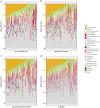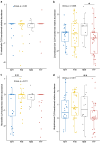The intestinal mucosa-associated microbiota in IBD-associated arthritis displays lower relative abundance of Roseburia intestinalis
- PMID: 40382763
- PMCID: PMC12087651
- DOI: 10.1080/19490976.2025.2505114
The intestinal mucosa-associated microbiota in IBD-associated arthritis displays lower relative abundance of Roseburia intestinalis
Abstract
The most common extra-intestinal manifestation (EIM) of inflammatory bowel disease (IBD), IBD-associated arthritis (IAA), occurs in 25-40% of patients and can be debilitating. In IBD, mucosal and stool microbiota richness is decreased, and compositional changes can precede or accompany disease onset. Likewise, spondyloarthritides are associated with altered gut microbiota, with overlapping bacterial signatures observed in IBD, suggesting key shared microbial factors are involved in both conditions. Much has been learned about the role of the intestinal microbiome in IBD, but less is known regarding its role in IAA. To address this knowledge gap, we analyzed the mucosa-associated intestinal microbiota of participants enrolled in the LOCATION-IBD cohort. Microbiota composition was established using 16S rRNA gene amplicon sequencing of intestinal biopsy samples taken from participants with IBD, with or without arthropathy. Microbiota samples clustered predominantly by participant, and similar taxa were present across the colon. The mucosal intestinal microbiota of females with IAA displayed a lower relative abundance of R. intestinalis, while males with IAA had a higher relative abundance of Corynebacterium, even when controlling for IBD-type, whether samples were taken from a site of inflammation and intestinal location. These findings indicate the mucosa-associated intestinal microbiota is associated with IAA in a sex-specific manner.
Keywords: Crohn’s disease; IBD-associated arthritis; Spondyloarthritis; enteropathic arthritis; mucosal gut microbiome; ulcerative colitis.
Conflict of interest statement
RKC has received income from consulting and participation in advisory boards for Abbvie, BMS Genentech, Gilead, Janssen, Magellan Health, Option Care, Pharmacosmos, Pfizer, Sandoz, and Samsung Bioepis, is a member of the Executive Committee for the IBD Education Group, has research grants from Janssen and Takeda, and is Scientific Co-Director of the CorEvitas Registry. JR is cofounder of LUCA Biologics and has received income from consulting for Biocodex.
Figures







References
MeSH terms
Substances
Grants and funding
LinkOut - more resources
Full Text Sources
Medical
Miscellaneous
